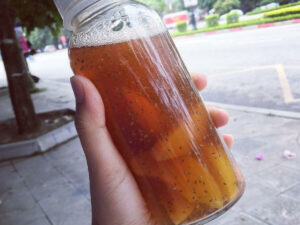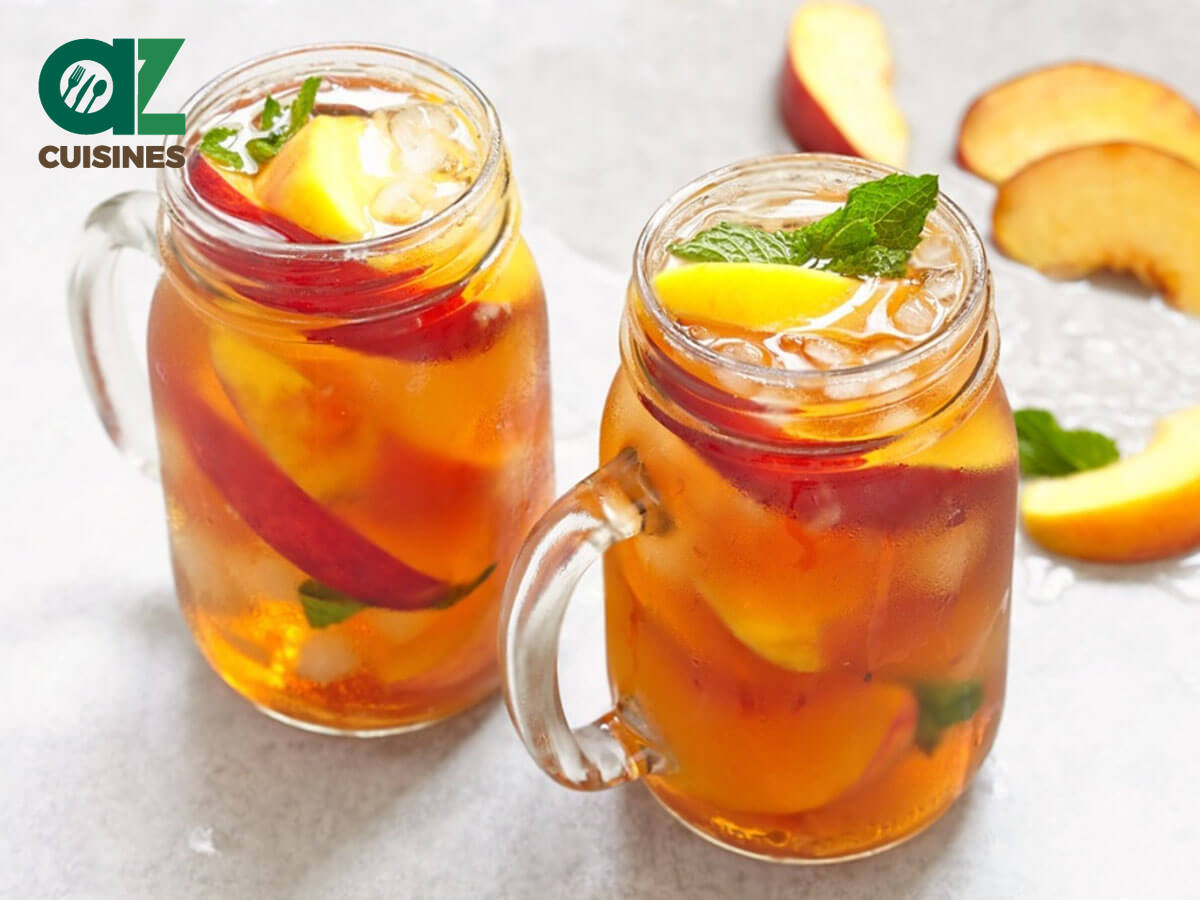Popular Trà Đào Variations

Trà Đào Ngâm

Trà Đào Cam Sả

Trà Đào Dầm

Trà Đào Hạt Chia

Trà Đào Kem Cheese
Trà Đào: Ingredients and Preparation
Main Ingredients
Main Preparing Method
Preparation Process
Trà Đào: A Deep Dive
Cultural Significance
Taste
Texture
Aroma
Color
Serving Style
Serving Temperature
Accompaniment
Occasions
Calories
Popularity
Popular Similar Drinks
- Trà Đá
- Trà Chanh
- Trà Tắc
- Trà Sen
- Thai Iced Tea
Popular Dining Area
Trà đào is a sweet tea in Vietnam that infuses tea with a peach aroma and slices of the fruit. In some cases, this Vietnamese peach tea is flavored with peach syrup instead, bringing both the aroma and sweetness.
When served, trà đào is often packed with ice for a refreshing experience, though a warm version is also popular for colder days. In Vietnam, it’s one of the common versions of flavored tea enjoyed on the streets of Vietnam.
Explore the various versions of trà đào and learn about the methods used to create this refreshing drink. Then, let the good and bad features of drinking trà đào help you decide whether this beverage is fit for your consumption.
Aside from that, you should peek at some of the inquiries of other readers about trà đào. Then, I’ll suggest you with a few drinks that are like trà đào.
Key Points
Trà Đào Images
What Are the Different Versions of Trà Đào?
Trà đào involves more than just combining tea with peaches; there are numerous variations with different ingredients that offer a range of flavors:

Trà Đào Kem Cheese
A creamy and rich variation, topped with a layer of cheese foam

Trà Đào Hạt Chia
Peach tea combined with chia seeds, adding a unique texture and health benefits to the drink

Trà Đào Dầm
This version involves muddled or crushed peaches in the tea

Trà Đào Cam Sả
A blend of peach tea with orange and lemongrass
Has a citrusy and aromatic twist

Trà Đào Ngâm
Peach tea with soaked or marinated peaches
These variations are just some of the few popular versions of trà đào, as the drink is easily adaptable with other elements. For that, make sure you don’t miss the process of materializing a glass of trà đào.
How Trà Đào Is Made?
To make trà đào, tea and peach are crucial elements to nail the flavor. Understanding the process of making trà đào is crucial to achieving the best taste:
Step 1: Tea Brewing
Begin by brewing your choice of tea – typically a black or green tea. Steep the tea leaves in hot water for a few minutes until the tea reaches the desired strength.
Step 2: Peach Preparation
While the tea is brewing, prepare the peaches. If using fresh peaches, wash, pit, and slice them. For a stronger peach flavor, you can muddle or crush some of the peach slices to release their juices.
Step 3: Combining Peach and Tea
Once the tea is brewed, remove the tea leaves and let the tea cool down a bit. Add the peach slices (and any peach juice if you muddled some) to the tea.
Step 4: Sweetening
Depending on your preference, sweeten the tea with sugar, honey, or peach syrup. Stir well to ensure the sweetener is fully dissolved.
Step 5: Chilling
Refrigerate the tea mixture to chill it thoroughly. This step is crucial for a refreshing iced trà đào.
Step 6: Serving
Serve the chilled peach tea over ice. For an extra touch, you can garnish with additional peach slices or a sprig of mint.
Later on, it’s important for people to know the benefits and drawbacks of drinking trà đào to avoid any unwanted effects.
Pros and Cons of Drinking Trà Đào
Below are some commonly noted positive and negative aspects of drinking trà đào:
Pros
Cons
Next, discover some of the common questions that readers often have about this Vietnamese version of peach tea.













Adam Sam
Senior Food and Drink Editor
Expertise
Food Writer & Recipe Developer, Recipe Tester, Bartender, Cooking-video Maker, Editor In Chief
Education
Adam Sam, an experienced food writer and recipe developer, is passionate about blending diverse culinary traditions, national dishes, and innovative beverages, showcasing his proficiency in both traditional and modern recipe testing.
As the Editor-in-Chief, he elevates culinary content from street food to fine dining, focusing on Western cuisine and types of drinks at azcuisines.com, and is professional in creating engaging cooking videos that simplify complex dishes and ingredients.
His passion for food is evident in his writing, where he uniquely merges various cultures, traditions, and contemporary trends, skillfully combining classic recipes with modern cooking methods.